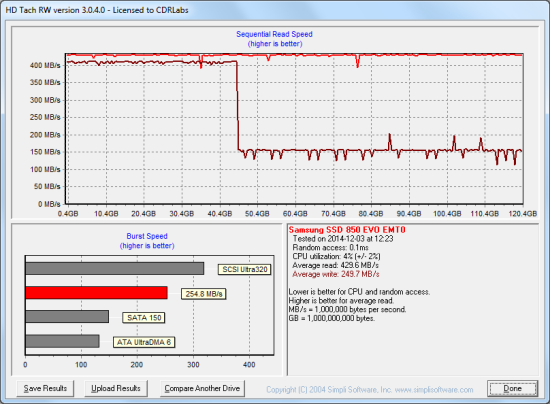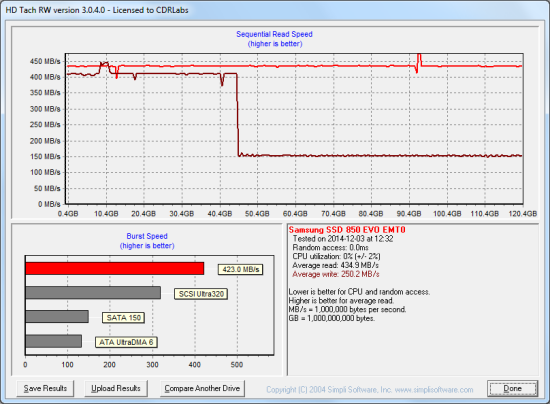TRIM Performance:
While SSDs offer many benefits, there are some downsides to using flash memory. One of the biggest issues people run into is performance degradation. Over time, an SSD will run out of fresh blocks and will have to write over data the file system has marked as deleted. This procedure is very complicated and can slow an SSD's write speeds considerably.
To address this problem, most manufacturers have added TRIM support to their SSDs. The TRIM command allows an operating system, such as Windows 7, to tell an SSD which data blocks are no longer in use. Using this information, the drive pro-actively erases these blocks and adds them to the free block pool.

To test the 850 EVO's TRIM and garbage collection functions, I first put the drive in a "dirty" state. I used Iometer to fill the entire drive and then ran a random write test for 30 minutes. This had little impact on the 850 EVO's read speed. However, its average writing speed dropped to a mere 16.7 MB/s.

Samsung SSD 850 EVO - Dirty
To see how well the 850 EVO could recover, I let the computer sit for about an hour and then reran the test. Looking at the screenshot below, you can see that the drive's average writing speed jumped back up to 249.7 MB/s.

Samsung SSD 850 EVO - After Trim
Lastly, I used Samsung's SSD Magician software to perform a secure erase of the 850 EVO. With the drive wiped clean, it had average read and write speeds of 434.9 MB/s and 250.2 MB/s, respectively.

Samsung SSD 850 EVO - Secure Erase
Final Thoughts:
Samsung set the bar pretty high when they introduced the 840 EVO. Despite its use of 3-bit (TLC) NAND, this consumer-grade drive delivered performance much like that of its higher-end sibling, the 840 PRO. With the 850 EVO, Samsung has raised the bar even further. By utilizing their new MGX controller and 3-bit 3D V-NAND, the company has been able to cut power consumption while improving both the endurance and performance of the drive.
Thanks to Samsung's TurboWrite technology, the 850 EVO performed relatively well throughout most of our tests. In our sequential read and write tests, the 120GB version of the drive was able to read at speeds as high as 552 MB/s and write at speeds in excess of 506 MB/s. It also had no problems holding its own when doing random reads, but lagged behind the other drives in our random write tests, producing only 46,000 IOPS at low queue depths. With RAPID mode enabled the results varied a lot from one benchmark to another, but even on the low end the drive's sequential read and write speeds increased by more than 60 MB/s.
While Samsung's TurboWrite technology works well under normal workloads, it does have its limitations. If you have a heavy workload, where a consecutive write operation exceeds the size of TurboWrite's buffer, the 850 EVO's write speed drops to non-accelerated levels. The speed and point where this happens varies based on the capacity but it was very apparent with the 120GB version of the drive. Needless to say, if you work with large files or use applications like Photoshop, you may want to look at the higher capacity versions of the 850 EVO or step up to the 850 PRO.
Fast read and write speeds aren't the only things the 850 EVO has to offer. Along with support for technologies like RAPID and TurboWrite, the drive features AES 256-bit full disk encryption and is compatible with both the TCG Opal and IEEE 1667 specifications. The 850 PRO also supports the SATA Device Sleep (DEVSLP) standard which extends the battery life of a device by reducing the drive's power consumption when it's not in use. To top it all off, the 850 EVO is covered by a generous 5 year warranty.
At this time, Samsung has not said when the 850 EVO will be available. However, if the suggested retail prices of the 120GB ($100), 250GB ($150), 500GB ($270) and 1TB ($500) versions are any indication, it could end up being an even bigger bang for your buck than the 840 EVO.

Highs:
- Equipped with 3-bit 3D V-NAND
- Available in 120GB, 250GB, 500GB and 1TB capacities
- Features RAPID mode and TurboWrite technology
- Excellent sequential read and write speeds under most conditions
- Good random read performance
- Performs equally well with compressible and incompressible data
- Good looking, ultra-slim design
- SATA 6Gb/s interface
- Large SDRAM cache
- Supports TRIM, garbage collection and wear leveling
- AES 256-bit full disk encryption
- TCG Opal and IEEE 1667 compliant
- Includes SSD Magician software and Data Migration Tool
- Reasonably priced
- 5 year warranty
Lows:
- Mediocre random write performance
- RAPID mode is Windows only

